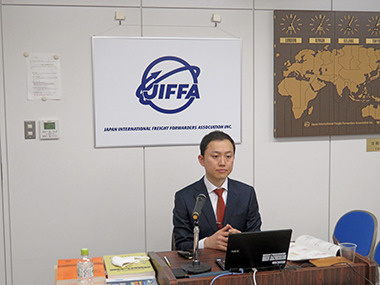News
JIFFA’s Public Relations Committee held on Tuesday a live streaming workshop to discuss the fundamental knowledge on the transport of hazardous materials by sea. Brought to the webinar as a lecturer was Mr. Kazuhiko Nonomura, the Research Team of Safety and Technology Division, Nippon Kaiji Kentei Kyokai (NKKK).
For the smooth and seamless international carriage of dangerous goods, globally common rules and regulations are needed for all of the maritime, airborne, overland and railway modes. In seaborne transport, to this end, the International Maritime Dangerous Goods (IMDG) Code was developed in accordance with recommendations from the United Nations, which contains lists of dangerous goods, basic requirements for containers and so on. Governments have established domestic laws according to the IMDC Code. In Japan, the Regulations for the Carriage and Storage of Dangerous Goods by Ships cover rules for moving hazardous items by ship and storing them on board ships.
To begin with, Mr. Nonomura gave briefings on the structure of such rules and regulations on dangerous goods. He then moved on to the variety of requirements adopted for the marine transport of individual hazardous materials. In reference to the Japanese rules and regulations, Mr. Nonomura explained the procedure of handling dangerous goods in an easy-to-understand ways, giving many examples of Packing, Mark and Label, Segregation and Dangerous Goods Packed in Limited Quantities.









